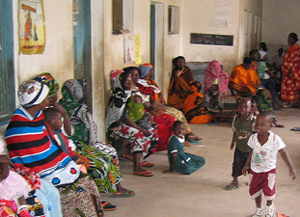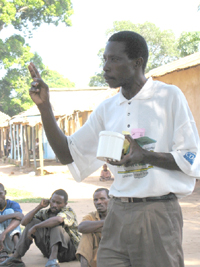 |
 |
 |
| Patients wait their turn to see the clinical officer at Kibiti Health Center, Tanzania (Courtesy: Ifakara Health Research and Development Center, Tanzania) |
 |
 |
On June 30, 2005, just prior to the G8 Summit in Scotland, President Bush
announced a major new US
initiative to fight malaria in Africa. The first three countries to
benefit from this Initiative will be Tanzania, Uganda and Angola.
Tanzania
- Population 35 million, all of whom live at risk of malaria, for at least part of the year.
- The third largest population at risk of malaria on earth.
- Malaria is the leading cause of patient visits to health facilities and of deaths in the country.
- One Tanzanian, nearly always a child, dies of malaria every five minutes.
Despite the grim statistics there is good reason to be hopeful that malaria can be controlled in Tanzania.
Ongoing Progress
Bednets
- Three factories produce mosquito nets that are sold with an insecticide treatment kit. Insecticide-treated nets (ITNs) prevent bites from malaria-carrying mosquitoes and can reduce child mortality by as much as 40%.
- More than 20% of households across Tanzania currently use ITNs.
- Tanzania has started a project to make ITNs more affordable to pregnant women, a group at high risk for malaria, by reducing the out-of-pocket cost from more than $3.00 to as little as $0.25 .
- Tanzania plans to distribute free ITNs in some of the most remote areas of the country, which also have the highest malaria risk.
 |
 |
| A health worker describes combination treatment for malaria to community members near Bungu Village, Tanzania (Courtesy: Ifakara Health Research and Development Center, Tanzania) |
 |
 |
Drugs
- Tanzania plans to introduce a highly effective combination treatment for malaria. Such combination treatments work quickly to prevent the disease from becoming severe or fatal. They may also slow down the appearance of drug-resistant parasites. However, they are much more expensive than conventional treatments.
- Effective combination treatments have already been tested in more than 5,000 children during clinical studies throughout the country.
- More than 1,250,000 people have benefited from combination treatments in an initial phase in the Rufiji District and the Zanzibar Archipelago.
- Tanzania plans to produce these highly effective treatments in-country, to reduce their price and the need to depend on foreign donors.
Thoughts from Tanzania about the President’s Malaria Initiative
● Dr. Alex Mwita, Manager of the National Malaria Control Program for mainland Tanzania:
“This announcement comes at exactly the right moment,” says Dr. Mwita, referring to President Bush’s announcement of up to $1.2 billion over the next 3-5 years. Dr. Muita’s program and its advisors had decided to recommend the combination treatment because other drugs were failing rapidly. It was a bold move, considering that the treatment would nearly double the total amount spent by the Ministry of Health for all drugs. Although their application for international assistance was approved, funding was committed for two years only. Dr. Mwita began to wonder if his team would introduce the new treatment only to run short of funds, and be forced to abandon it. The President’s Malaria Initiative, particularly its emphasis on procuring the necessary commodities for effective malaria control, was welcomed and gave the Ministry of Health the confidence to begin implementing its plans for delivering combination treatments.
● Mr. Abdulla Suleyman Ali, Director of the Malaria Control Program for Zanzibar:
Unlike the people in much of mainland Tanzania, most inhabitants of the Zanzibar archipelago live in large villages or towns, within walking distance of a health facility. Effective combination treatments were introduced in the semiautonomous region of Zanzibar in 2003. Already, health officials have seen an increase in health facility attendance, as people choose this option over self treatment with less effective medicines purchased from shops. However, these communities lag behind in malaria prevention: insecticide-treated mosquito nets (ITNs) are less commonly available on the islands. And additional transport costs make many manufactured goods unaffordable for the poor households who are most at risk of malaria. Mr. Ali is hopeful that the additional support promised in the President’s Malaria Initiative will allow him and his colleagues to provide these much needed ITNs free of charge.
● Dr. Hassan Mshinda, Director of the Ifakara Health Research and Development Center (IHRDC):
While the promise of resources to obtain the needed drugs and mosquito nets (ITNs) is highly encouraging, it also raises many questions about how to deliver these interventions in ways that are efficient, equitable and locally appropriate. The IHRDC is a leading partner for in-country malaria activities sponsored by the United States and other international partners. Dr. Mshinda has seen a number of promising interventions for child health fail to be delivered effectively or fail to reach the very groups at highest risk. The center hosts several research projects that focus on delivering health interventions under real world conditions. Dr. Mshinda describes “equity-effectiveness” as the best standard for malaria treatment and prevention: the interventions should actually reduce illness and premature death, and everyone at risk should have equal access to these benefits.
● Dr. Rose Nathan, demographer at IHRDC:
Measuring the impact of malaria interventions on overall survival is important, but it can often be quite difficult in African settings. Few people die at hospitals, thus the usual health statistics often tell very little about whether or not the interventions are really working and decreasing deaths. Public health officials often rely on periodic surveys such as the Demographic and Health Surveys to measure health coverage and to search for broad trends in mortality. Dr. Nathan monitors trends in morbidity and mortality and other events in a select population over time. Through the largest demographic surveillance system in Africa, covering 56 villages in Kilombero, Ulanga and Rufiji Districts, she and her colleagues track the coverage of malaria interventions, and whether they achieve measurable benefits in survival and health status. They can also establish whether these benefits reach only the relatively well off, or also the poorest households. The center’s work has already helped to shape policy on insecticide-treated bednets, delivery of effective combination treatments, intermittent preventive treatment for malaria in pregnant women and infants, and integrated management of childhood illness.
● Dr. Vera Juma, St. Francis Designated District Hospital, Ifakara:
The President’s Malaria Initiative is particularly encouraging because it offers support for much needed malaria-related commodities, their effective delivery, and appropriate monitoring and evaluation of their health benefits. The success of this massive effort will ultimately rest on the talents and skills of Tanzanian health workers, technicians and scientists. Although malaria has long been the single most important cause of death in Tanzania, many of the country’s best and brightest have chosen other fields with more resources and opportunities. Equipping Tanzanians with the skills necessary to undertake and maintain major strides in malaria control will now be essential. And many young Tanzanians are gearing up for the task. Dr. Juma is one. As a locally trained medical doctor, she has seen the devastating effect that malaria can have especially for pregnant women and their children. Dr. Juma is currently providing intermittent preventive treatment for pregnant women, who are at high risk of malaria, and following them and their children after delivery. In order to prepare herself to contribute to the fight against malaria, Dr. Juma has found international support to obtain advanced training in public health and epidemiology in Belgium. She looks forward to using her new skills to organize and lead effective interventions against malaria in Tanzania.
 |
 |
| Dr. Herry Kassala examines a sick child at his home in Ikwiriri Rufiji District, Tanzania (Courtesy: Ifakara Health Research and Development Center, Tanzania) |
 |
 |
Contributed by the Ifakara Health Research and Development Center, Ifakara, Tanzania.
Page last modified : July 26, 2005
Content source: Division of Parasitic Diseases
National Center for Zoonotic, Vector-Borne, and Enteric Diseases (ZVED)
|
 |
|





